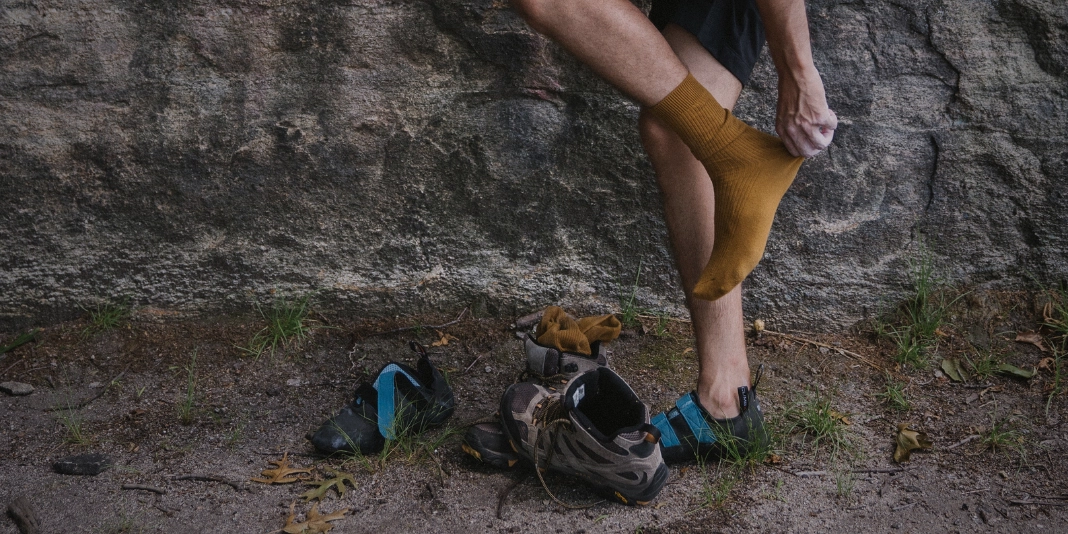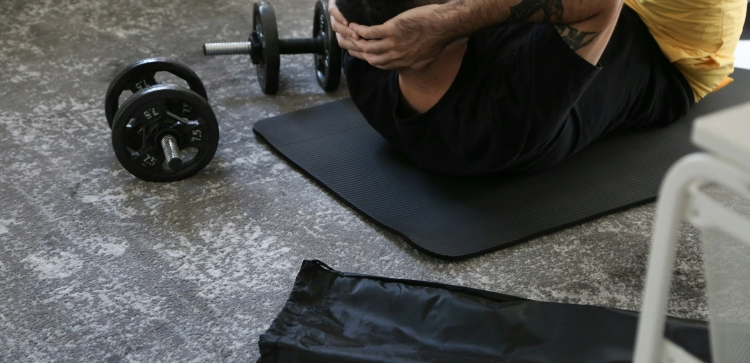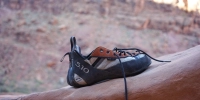Should You Wear Socks With Climbing Shoes? Here's What You Need To Know

If you have ever been climbing, you may have asked if you should wear socks with your climbing shoes. While the question is a simple one, the answer is not so simple, as whether you should wear socks with climbing shoes or not is one of the most debated topics in the climbing community.
Some climbers swear by wearing socks, while others find them unnecessary and a performance reducer. So, what's the deal? Let's break down the pros and cons of wearing socks with climbing shoes.
- The Pros Of Wearing Socks With Climbing Shoes
- 1. Wearing Socks Can Provide Moisture Control
- 2. Socks Can Improve Hygiene & Reduce Bad Odors
- 3. Socks Help With Comfort & Pain Reduction
- 4. Wearing Socks In Loose Climbing Shoes Can Provide A Better Fit
- 5. Wearing Socks With Climbing Shoes Can Help Break Them In
- The Cons Of Wearing Socks With Climbing Shoes
- 1. Wearing Socks With Climbing Shoes May Reduce Your Sensitivity
- 2. It May Be Too Bulky To Wear Climbing Shoes With Socks
- 3. Socks May Cause Your Feet To Slip
- What's The Verdict?
- Tips For Wearing Socks With Climbing Shoes
- 1. Choose Thin Socks
- 2. Wear Toe Socks
- 3. Make Sure The Sock Fits Properly
- 4. Try Different Sock And Shoe Combinations
- 5. Buy Dedicated Climbing Shoes Socks
- Wearing Socks In Rental Climbing Shoes
- In Conclusion - Should You Wear Socks With Climbing Shoes?
The Pros of Wearing Socks with Climbing Shoes
While many climbers may be against it, there are in fact some benefits to wearing socks with climbing shoes:
1. Wearing Socks Can Provide Moisture Control
Climbing can be a sweaty activity, and wearing socks can help keep your feet dry and comfortable. Socks can absorb moisture, preventing your feet from slipping and sliding inside your shoes due to the moisture. This can improve your grip and prevent blisters.
In addition to keeping your feet dry, moisture-wicking socks can also help prevent fungal infections like athlete's foot. Fungi thrive in warm, moist environments, so wearing socks that can absorb and wick away moisture can help keep your feet healthy and fungus-free.
2. Socks Can Improve Hygiene & Reduce Bad Odors
Climbing shoes can get pretty smelly, especially if you're climbing frequently. Wearing socks can help keep your shoes cleaner and prevent the buildup of bacteria and odors.
Sweat and moisture from your feet can accumulate inside your shoes, creating an environment that is conducive to the growth of bacteria and fungi. This can lead to unpleasant odors and even skin infections like athlete's foot. Wearing socks can act as a barrier between your feet and your shoes, preventing the sweat and moisture from coming into direct contact with the shoes.
In addition to preventing odors and infections, wearing socks with climbing shoes can also make it easier to clean and maintain your shoes. The socks can absorb some of the sweat and dirt that would otherwise accumulate inside the shoes, making it easier to clean and dry them after use.
3. Socks Help With Comfort & Pain Reduction
Wearing socks with your climbing shoes can provide added comfort and reduce the risk of pain and discomfort during your climb. Climbing shoes are designed to fit tightly, and while this is necessary for good grip and control, it can also cause friction and rubbing against your skin. Over time, this can lead to blisters, calluses, and soreness.
By wearing socks, you can create a barrier between your feet and shoes, reducing the amount of friction and rubbing. The extra layer of cushioning that socks provide can also absorb shock and impact, reducing the pressure on your feet. This can be particularly beneficial for longer climbs or for climbers with sensitive feet.
When choosing socks to wear with your climbing shoes, look for options that are thin and breathable to avoid adding too much bulk inside your shoes. Some climbers prefer to wear toe socks, which can help separate and protect each toe, reducing the risk of blisters and other foot injuries.
4. Wearing Socks In Loose Climbing Shoes Can Provide A Better Fit
Wearing socks with your climbing shoes can also provide a better fit, especially if your shoes are slightly bigger or looser than you would like. Socks can fill in any empty space between your feet and the shoes, creating a snugger fit that is more comfortable and secure.
When your feet slide around inside your shoes, you may lose grip and control, which can be dangerous when climbing. Wearing socks can help prevent this from happening by providing an additional layer of cushioning that can absorb moisture and reduce the amount of sliding, while also making the general fit of the shoes tighter.
If you have wide or oddly-shaped feet, it can be difficult to find climbing shoes that fit perfectly. In these cases, wearing socks can help fill in any gaps or spaces between your feet and shoes, providing a better fit that is more comfortable and supportive.
5. Wearing Socks With Climbing Shoes Can Help Break Them In
When you first get a new pair of climbing shoes, they may feel stiff and uncomfortable. Breaking them in can take some time and patience, and wearing socks can help make the process easier.
By wearing a thin pair of socks in your new climbing shoes, you can help stretch the shoes out and mold them to your feet more quickly. The socks can create a barrier between your feet and the shoes, reducing the amount of rubbing and friction that can cause discomfort and pain during the break-in period. The socks can also help absorb moisture and sweat, keeping your feet dry and comfortable.
It's worth noting that you should choose thin socks when breaking in new climbing shoes. Thick socks can add too much bulk inside the shoes and may prevent them from molding to your feet properly. Additionally, if you plan to climb without socks after the break-in period, it's important to consider the fit of your shoes with socks on. Make sure they fit snugly and comfortably with socks, so that you can maintain control and grip on the rock.
The Cons of Wearing Socks with Climbing Shoes
While there are many benefits to wearing socks with climbing shoes, there are also a few potential drawbacks to consider:
1. Wearing Socks With Climbing Shoes May Reduce Your Sensitivity
While there are certainly benefits to wearing socks with climbing shoes, it's worth noting that they can also have some drawbacks. One potential drawback is reduced sensitivity.
When you wear socks with your climbing shoes, you are adding an additional layer between your feet and the rock. This can reduce the sensitivity of your feet, making it harder to feel the rock and judge your foot placements accurately. This can be especially important when climbing on difficult or technical routes where precision and balance are key.
Additionally, the thickness of your socks can also impact sensitivity. Thicker socks may provide more cushioning and comfort, but they can also reduce sensitivity even further. Thinner socks, on the other hand, may provide more sensitivity, but may not be as comfortable or protective.
2. It May Be Too Bulky To Wear Climbing Shoes With Socks
The thickness of your socks can alter the fit of your shoes, making them feel too tight or loose, which can be a problem if you're struggling to find well-fitting shoes. Additionally, the added bulk can make it harder to grip small holds or feel the rock beneath your feet.
3. Socks May Cause Your Feet To Slip
Socks can sometimes cause feet to slip inside climbing shoes due to the added layer of material. This can create a barrier between the foot and the shoe, reducing the amount of friction and causing the foot to slide around inside the shoe. Additionally, socks may be more likely to bunch up or fold over inside the shoe, which can also contribute to slipping.
It's important to note that this is not always the case. Many climbers wear socks with their climbing shoes without experiencing any slipping.
What's the Verdict?
The decision of whether to wear climbing shoes with or without socks ultimately comes down to personal preference and individual factors such as foot shape, sensitivity, and comfort. Some climbers find that socks are essential for their comfort and performance, while others prefer the direct contact between their feet and the shoes. It's worth trying both options and seeing which one works best for you.
Tips for Wearing Socks with Climbing Shoes
If you decide to wear socks with climbing shoes, here are a few tips to make the most of this setup:
1. Choose Thin Socks
Thinner socks will provide moisture control and comfort without interfering with the fit and sensitivity of your shoes.
2. Wear Toe Socks
Toe socks can help separate and protect each toe, reducing the risk of blisters and other foot injuries.
3. Make Sure The Sock Fits Properly
Ill-fitting socks can bunch up or slide around inside your shoes, creating discomfort and reducing performance. Make sure your socks fit snugly without bunching or slipping.
4. Try Different Sock And Shoe Combinations
Different socks and shoes may work better together than others. Experiment with different combinations to find the one that works best for you.
5. Buy Dedicated Climbing Shoes Socks
Climbing shoes socks are typically thin and made of moisture-wicking materials, such as nylon or polyester. They are dedicated socks for climbing shoes, and are designed to fit snugly on your feet without adding any unnecessary bulk or padding. This allows you to maintain maximum sensitivity and grip while climbing, which is essential for safe and effective climbing.
Wearing Socks In Rental Climbing Shoes
Wearing socks in rental climbing shoes can be a good idea. Rental shoes are often worn by many people, who all sweat in them for an extended period of time. This means there is a higher risk of foot fungus and bacteria being transferred between climbers. Wearing socks can help protect your feet from these potential infections and can also protect the people who will wear the shoes next.
In Conclusion - Should You Wear Socks With Climbing Shoes?
Whether you should wear socks with climbing shoes or not depends on your personal preference. No one can tell you what is right or wrong for your feet when it comes to socks, other than yourself.
Try out both options, and see which one you prefer.











